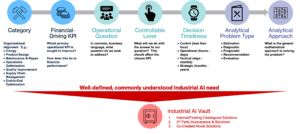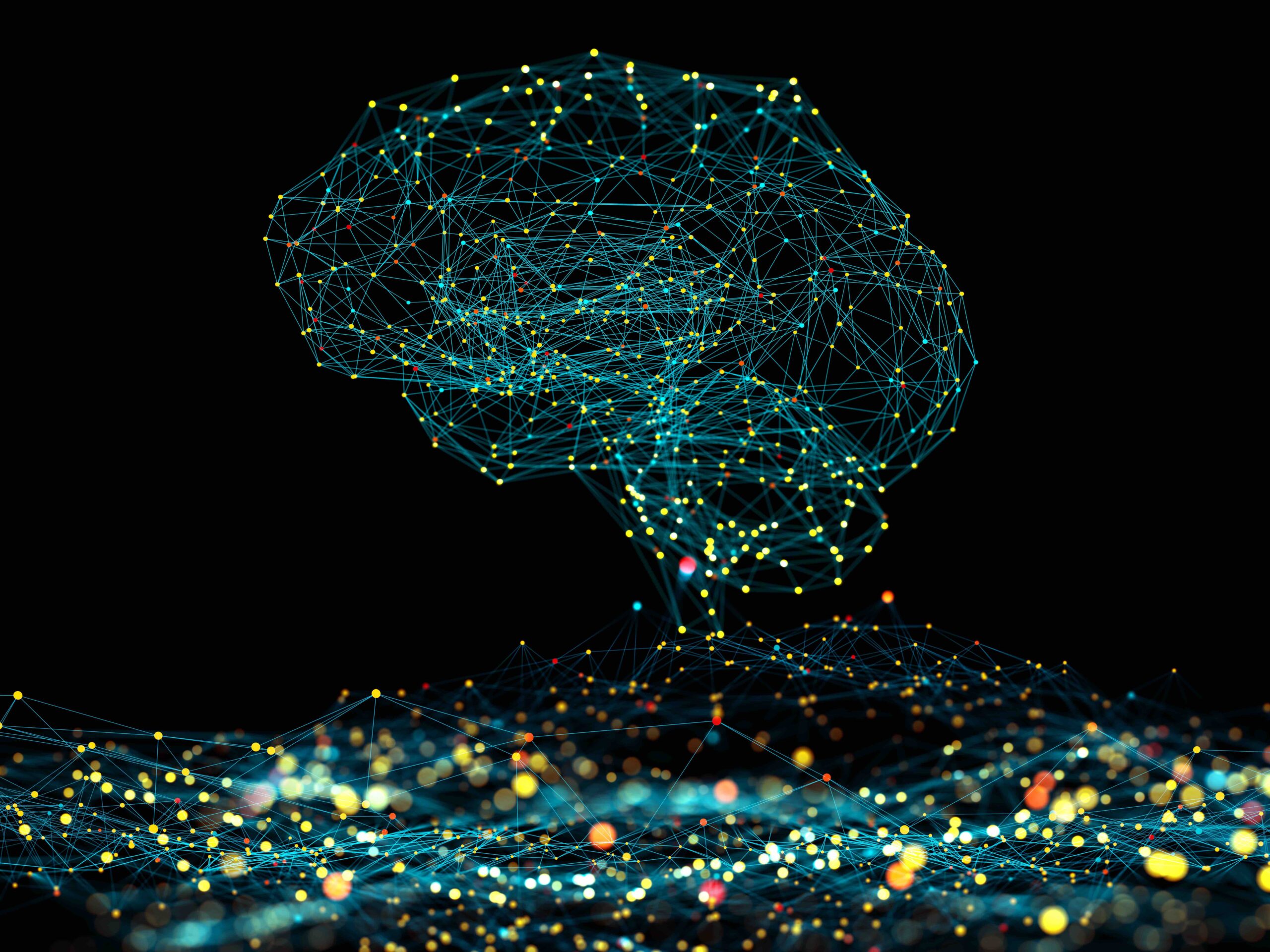February 5, 2024
Artificial Intelligence (AI) has been pervading and transforming our lives, from the face-recognition unlock function of smartphones and personalized news feeds on social media to recommendation systems on e-commerce and streaming platforms.
While these consumer-facing AI applications have greatly enhanced convenience and personalization, Industrial AI, the unique application of AI in industrial domains, holds the potential to revolutionize many industries, such as manufacturing, energy, mining, and logistics, to make a more profound impact on our society and at a larger scale.
In this blog, the first in a three-part series, we will outline the challenges and best practices that we have overcome ourselves, as well as continue to witness as we guide hundreds of our customers globally conquer and successfully implement.
It’s estimated that the potential value at stake from AI in industries is about 10 to 15 trillion dollars, with more than 1/3 of that, or 3.5 trillion dollars coming from AI models and applications deployed in supply chain management and manufacturing operations. By integrating and adopting AI-based solutions (combining data science, machine learning and related technologies), industrial organizations can harness the power of data-driven informed decision-making to achieve streamlined and optimized operations, enhanced safety, increased sustainability, efficiency, productivity, profitability, and many more. With these promises, Industrial AI is regarded as the cognitive engine and key enabler of the fourth industrial revolution.
We see the following as a few areas of impact of Industrial AI, including:
- Manufacturing organizations seek to “do more with fewer resources”, and commonly look to digital technology as a solution as part of continuous improvement programs.
- Most manufacturers have teams dedicated to Industry 4.0 (“I4.0”) or “manufacturing digitization”; many have executive leaders responsible for this and many have formalized “product owners”.
- IT organizations are frequently focused on building efficient and scalable platforms to support Industrial AI, rather than experimenting with proof of concepts.
- The enabling technology capabilities and technology eco-system is approaching ubiquitous: Many software firms provide IIoT platforms, the major cloud hyper-scalers have dedicated efforts around Industrial AI and thousands of “.ai” boutique firms offer analytical expertise.
- Manufacturing engineers are exiting academia more technology-savvy and statistics-capable than ever before, ready and able to apply digital tools such as Industrial AI.
While the potential value of Industrial AI is tremendous, value realization is still very low; about 50 to 60 percent of companies have deployed AI but have not scaled it. According to various surveys, many industrial organizations continue to face many business and technical challenges. We highlight the three crucial challenges here:
Challenge #1. Lack of a compelling, business-aligned transformation roadmap
Often, digital initiatives are aligned by “digital maturity”, or a linear progression such as
- from Descriptive to Predictive to Prescriptive,
- or from Connect to Visualize to Insight to Recommendation to Automated.
This maturity is often driven by technology enabled and/or technical support capability. This IT capability model, however, is misaligned with business or operational problem-solving needs. “We aren’t there yet” is an unfortunate reply when presenting a moderately complicated Industrial AI solution to address a critical business or operational issue.
Also, IT-Operations communication channels and tools must be improved: Operations must recognize IT constraints and assure to build this into the feasibility side of Industrial AI project definitions. Meanwhile, IT must appreciate and fully understand the operational value proposition of the Industrial AI solution in order to appropriately prioritize.
Challenge #2: Requirement of multi-disciplinary technical expertise
Applying AI to solve industrial challenges and drive tangible business impact is hard! It requires multi-disciplinary skills, working in-concert: domain expertise/operational technology (OT), AI, and digital infrastructure.
Further, industrial AI applications often encounter a variety of technical challenges because of its intricate nature and stringent requirements for worker safety, reliability, data privacy and system robustness.
In addition, the data generated in industrial settings usually exhibit high heterogeneity and complexity, including both structured and unstructured formats, complicating data management activities.
Challenge #3. Complexity of mapping business need to technical capabilities
Industrial processes are usually complex and consists of interconnected subprocesses. Many times, different working conditions and scenarios may be involved and there are lots of inherent uncertainties in many real-world business environments. For example:
- Customer demand is highly variable.
- Equipment fails unexpectedly.
- Environmental conditions are constantly changing.
Even well-defined business needs and objectives have nuances that need to be well understood and factored into solution development.
Meanwhile, the portfolio of technologies and solutions available to the Industrial AI practitioner is vast, often novel or unproven, and rarely well-catalogued.
Aligning complex requirements to complex solutions, often under the watchful eye of a return-on-investment expectation, requires considerable leadership and proficiency.
What Can We Do?
We believe that the onus on business architects to connect dots between what’s been done before and problems the manufacturer faces is the Industrial AI adoption bottleneck.
We call on industry groups and industrial digital transformation leaders to think broader and deeper about industry-specific Industry AI taxonomies. A structured taxonomy for Industrial AI will accelerate solution realization and increase value delivered. It provides:
- A clearly articulated business value statement supports tying Industrial AI initiatives to outcomes.
- A common definition of use-cases and solutions supports collaboration across factories or industries.
- A structured categorization scheme that helps ease matching AI solutions with the operational needs.
- A common language allows for operations and AI experts to better work together.
In the past decade, Hitachi have leveraged our deep expertise in both OT and IT and accumulated extensive experience helping our industrial customers overcome the challenges on their digital transformation journeys. In particular, to help our customers identify the pain points and lay out the AI transformation roadmap, we have developed a systematic industrial AI taxonomy that covers an essential set of business problems faced by customers from various industries where AI can drive better business outcomes.
The Hitachi Industrial AI taxonomy (described in the Figure 1) proposes a structured and linear method of identifying, describing and defining Industrial AI problems: business outcome to operational problem to analytical approach. The framework enforces classification of problems and solutions to encourage reuse and reapplication. The framework is also a tool to help communication between business, operations, and technologists. The general use of the framework is described below.

Figure 1: Hitachi Industrial AI Taxonomy Framework
1. Organize by Operational Domain: The broadest categorization of problem-sets, intentionally aligned to typical operational organizations
2. Define Operational Problem: A clear and concise problem statement is critical to align all parties. Identification of desired operational outcome (KPI) and articulation of what is going to change for this outcome to be achieved is critical and often omitted. This includes:
-
- KPI sought to improve
- Decision we are looking to make
- What lever can be pulled based on the result
- Timeliness of the decision-making: seconds, hours, days, months
3. Define Analytical Problem: A definition of how the problem should be solved and key mathematical principles.
-
- Analytical Problem Type:
- Analytical (mathematical) Approach
4. Select from a bank of Implementation Solutions: Products, Accelerators and Examples available to address the Industrial AI solution.
| Category | Quality Improvement |
| Primary KPI | First Pass Quality |
| Operational Question | Which setpoints should change or be constrained to? |
| Controllable Lever | Production Control |
| Decision Type | Tactical (days – months) |
| Analytical Problem Type | Recommendation |
| Analytical Approach | Operating Envelope Recommendation |
Beyond our Industrial AI cataloguing work, our extensive experiences have proven that our diverse and deep AI expertise can be leveraged to develop advanced solutions to cope with some of the technical challenges. Solving real-world complex industrial problems often requires innovations created by drawing advancements from multiple AI sub-fields such as traditional machine learning, deep learning, reinforcement learning, statistics, operations research, and optimization. We will showcase our AI technology innovations in following posts.
In the second part of this blog, we will get into some specific areas of Industrial AI: Dynamic Scheduling and Asset Management. Stay tuned!
Authors:
David McKnight, Director of Digital Manufacturing Solutions, Hitachi Digital Services
Haiyan Wang, Principal Research Scientist and Manager, Hitachi America Limited







